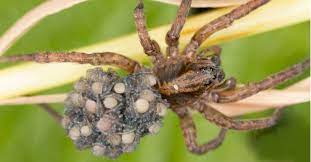Super Spooky Spiders
During the Middle Ages, people believed that spiders assisted witches in casting spells. Spiders are also thought to be mythical creatures who are storytellers and oracles due to their web-making abilities. If you see a spider on Halloween, legend has it that it's the spirit of a dead loved one watching over you.
What are spiders?
Spiders are arachnids that are as diverse as they are fascinating. Have you ever heard of spiders that live in groups? What about vegetarian spiders? All spiders produce silk, have eight legs, and have two main body parts.
Are spiders dangerous?
Most spiders are shy, nocturnal, have poor vision, and live in dark moist places. Although many people (such as my friend Charlotte) are afraid of spiders, spiders are more afraid of us than we are of them. The only type of spider in Canada that could potentially harm a person is the widow—they are rare around here and their bites are rarely fatal. Spiders just want to be left alone, and they don't deserve the bad reputation we've given them.
Where do spiders live?
Spiders live on every continent except Antarctica, and they live in almost every habitat. You'll find spiders in deserts, jungles, grasslands, forests, swamps, backyards, and the diving bell spider (left) even lives almost entirely underwater! The only habitats spiders don't live in are polar regions, the tops of mountains and in the ocean (though some spiders have ventured to the ocean's edge). Spiders live anywhere they can get food, water, and shelter.What do spiders eat?
Most spiders are exclusively carnivores, feasting on small bugs and insects. For some, the menu includes larger animals like birds, frogs, and lizards. One spider out of over 40 000 species is (mostly) vegetarian. The Bagheera kiplingi (right) is a special species of jumping spider that feeds off of leaves and nectar from acacia trees.
How do spiders hunt?
Spiders are perhaps most well known for their iconic webs that they use to catch prey. All spiders produce silk, but in fact, only about half of them make webs. Some spiders spend their time lying in wait for prey to wander by. Trapdoor spiders create special in-ground "trapdoors" made of plants, soil, and silk. They spend most of their life in their burrow, and they catch prey by quickly emerging from the trapdoor and pulling an unsuspecting insect under. Some spiders (such as wolf spiders and tarantulas) chase down their prey. Jumping spiders prefer to leap on their prey from afar.
Do spiders take care of their young?
Do spiders live in groups?
The vast majority of spiders are solitary, however, there are a few species of "social" spiders. Social spiders live colonies that can range anywhere from a few dozen spiders to thousands of spiders. They share childcare duties, hunt in groups to catch and share larger prey, and help make repairs on their communal web. Unlike ants or bees, spiders share tasks and resources evenly— there is no 'queen' spider.









I love the little spiders at the bottom! Spiders are so interesting!
ReplyDeleteI love the little spiders at the end! Spiders are so interesting!
ReplyDeleteI now feel more at ease sharing our home with a few spiders. And, the image of the jumping spider is unexpectedly adorable.
ReplyDeleteSpiders make fascinating subjects for photography. They’re obvious to being observed sometimes. I wonder if they have very good vision?
ReplyDeleteBats, toads, black cats, owls
ReplyDeleteWHAT??? SOCIAL SPIDERS EXIST? AWESOME! MUST DO MORE RESEARCH NOW...
ReplyDeleteIt's funny that the end of the blog literally says "What animals do you associate with Halloween? Let me know in the comments below" and only one person has done that. The first animal that comes into my head would be spiders. I also think of pumpkins and ghosts but those don't match the criteria of 'animals'.
ReplyDelete